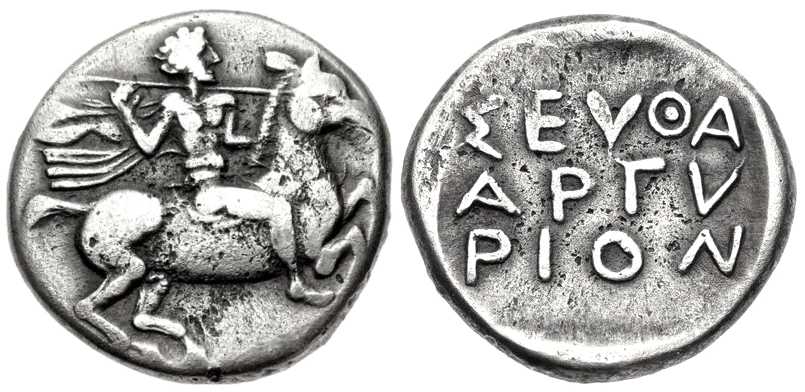| 424 BC - 405
BC |
Seuthes I Rex Thraciae
Σεύθης A' Βασιλέας Θράκης
| Didrachm / AR 21 |
SHH vc2703 |
 |
| Parameter Obverse Reverse Notes Reference |
8.55 g 20.8-21.9 mm 1:00
o'clock VF ρ = 9.88 g/cm^3 σ(240 Hz) obv. 51.6-55.7, rev. 52.9-59.0 MS/m Ag = 99.5 %, Cu 0.5 %, Pb 0.0 % Bearded horseman galopping right, holding reigns in left hand and spear in right. ΣΕVΘA / ΑΡΓV / ΡΙΟΝ in three lines within incuse. This is the second
of two known coins (as of September 2011), the first is in the
collection of
the Cabinet des Médailles, Paris. The Paris specimen is shown in
Topalov (2005) and Youroukova (1992) holed. On the photograph of Peter
(1997) the hole appears to have been closed because it was talken from
a plaster copy.
"Youroukova argued against the authenticity of
this didrachm type, but reversed her condemnation in a later article:
Y.
Youroukova, “Le monnayage du souverain thrace Seuthès II” in
Kraay-Mørkholm
Essays, pp. 317-21. While most authors attribute this issue to Seuthes
I, the
evidence is far from conclusive. The find evidence for all the silver
coins in
Seuthes’ name is practically nonexistent, so stylistic and metrological
data
provide the only clues for dating, and these can only suggest a date of
issue
in the period of the mid-5th to mid-4th century BC" [auctioneer].
de Luyns 1807; Babelon Traité IV
1290; Moushmov 5688 (425-405 BC);Modern Forgery identified from the material composition. Peter p. 76.1 (405-386 BC); Sear Greek --- (after 424 BC); Topalov (2005) 71 (Seuthes I 424-405 BC); Youroukova (1976) 26 (405-391); Youroukova (1992) 38 (394-387 BC) |